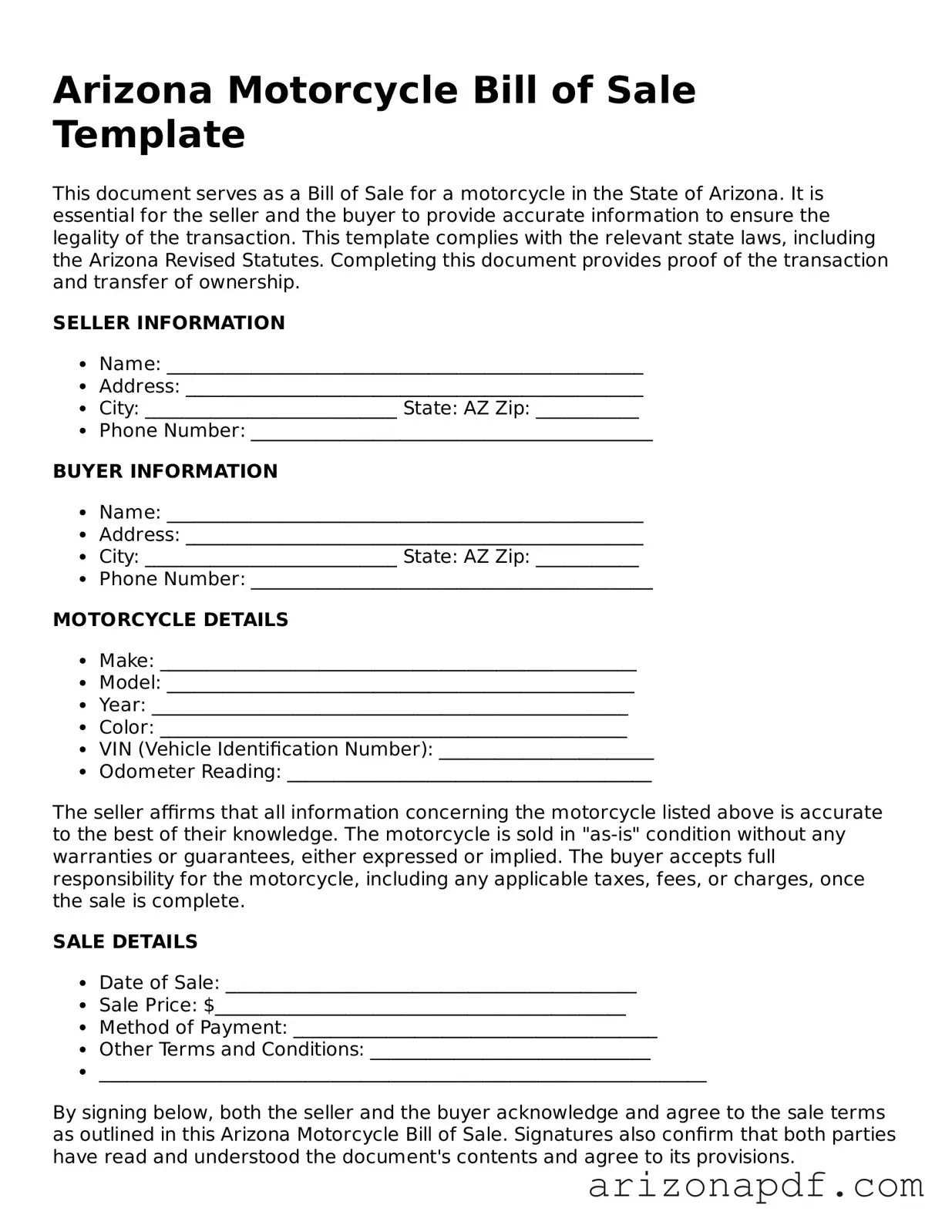The Arizona Motorcycle Bill of Sale form shares similarities with the Vehicle Bill of Sale form, commonly used in the sale and purchase of cars or trucks. Both serve as legal documents that capture the details of a transaction between a buyer and a seller, including the date of sale, purchase price, and identification specifics of the vehicle (or motorcycle), reinforcing the transfer of ownership. These documents are crucial for registration and titling processes in their respective departments of motor vehicles.
Comparable to the Trailer Bill of Sale form, the Motorcycle Bill of Sale supports the transfer of ownership for a different type of vehicle. The Trailer Bill of Sale focuses on documenting the sale of a vehicle specifically designed to be towed by another vehicle. Nevertheless, both forms perform the similar essential role of recording transaction details such as identity of the buyer and seller, sale price, and vehicle description, providing a legal basis for ownership transfer.
Similar to the Boat Bill of Sale form, which is used for the transfer of ownership of a watercraft between parties, the Motorcycle Bill of Sale serves the same purpose but for motorcycles. Each type of bill of sale is tailored to the specifics of the vehicle type it covers, detailing information pertinent to the vehicle's identification, such as hull number for boats or VIN for motorcycles, ensuring the document's adequacy in evidencing the agreement.
The Firearm Bill of Sale form, while distinctly different in the type of item it covers, is analogous in function. This document formalizes the sale and transfer of ownership of a firearm from a seller to a buyer. Like the Motorcycle Bill of Sale, it includes critical transaction details like names of the parties involved, description of the item, and sale price, playing a similar role in the respective registration processes when required.
The General Bill of Sale form is akin to the motorcycle-specific version but with a broader application. It can apply to various personal property sales, from electronics to furniture, lacking the vehicle-specific details but matching in the fundamental function of recording a transaction's key aspects, including parties involved, item description, and purchase details to establish proof of ownership transfer.
The Arizona Motorcycle Bill of Sale is also similar to the Equipment Bill of Sale form, used specifically for the sale of machinery or equipment. Both documents outline the transaction's specifics, including the buyer and seller's information and the item's description and sale conditions, facilitating a clear transfer of ownership of valuable assets.
Another related document is the Animal Bill of Sale, especially for high-value livestock or pets. Though it pertains to living creatures rather than inanimate objects, the core essence of documenting the sale and transfer of ownership, detailing the parties involved, and providing a description of the animal, mirrors the structure and intent of the Motorcycle Bill of Sale.
Like the Business Bill of Sale, which is utilized during the sale of a business, capturing details about the transaction, the buyer, the seller, and terms of the sale, the Motorcycle Bill of Sale documents similar information for a different context. Both forms are pivotal in the legal process, serving as evidence of ownership transfer.
The Property Bill of Sale is designed for real estate transactions and, though dealing with more complex and higher-value assets than a motorcycle, shares the purpose of providing a written record of the sale, including details on the buyer, seller, and the property sold. This form strengthens the legal account of the transaction, akin to the Motorcycle Bill of Sale’s role in vehicle sales.
Lastly, the Airplane Bill of Sale form, critical in the aviation sector for documenting the sale and purchase of aircraft, parallels the Motorcycle Bill of Sale in structure and intent. It specifically adapts to an aircraft's unique identification needs, yet it universally confirms the change of ownership, reinforcing the legal standing of the transaction, just as the motorcycle form does for motor vehicles.
